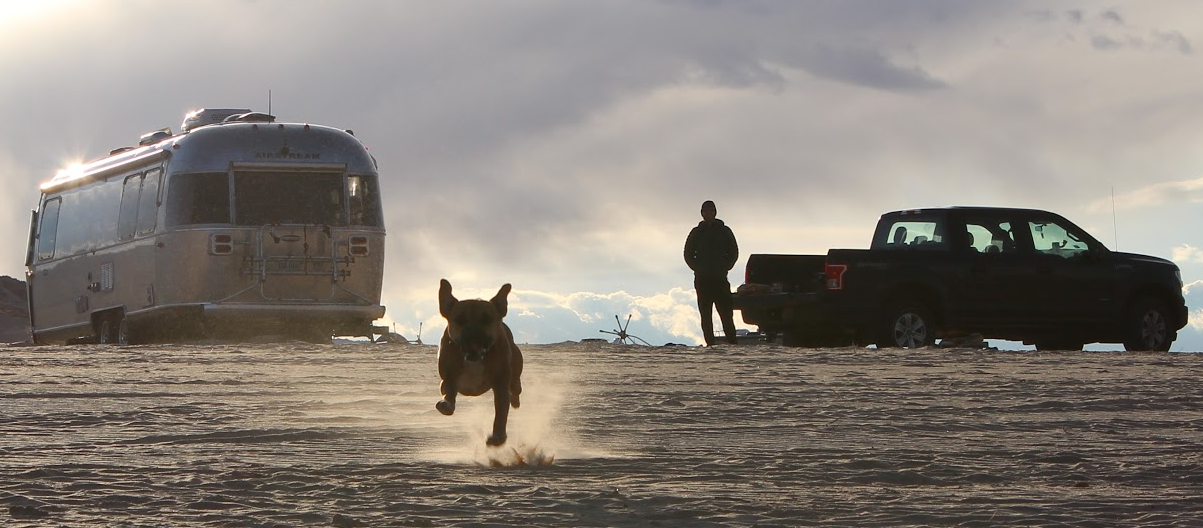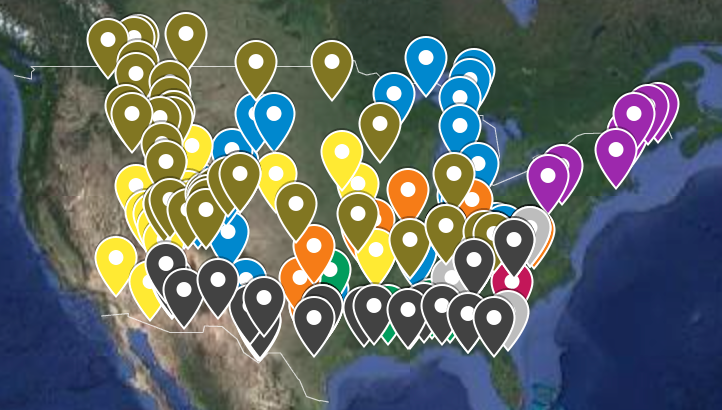We visited Joshua Tree in November 2018, during Big Trip #2.

We finally got to California in the Airstream! Bugsy got a new state! (She’s up to 36 now!) For some reason–ignorance, I guess–we weren’t sure if Joshua Tree was worth rearranging our schedule and driving many extra hours to visit. The answer is yes. Go there. It is a phenomenal park.

What exactly is a Joshua tree, you ask? It’s actually a yucca–the largest yucca–and a member of the Agave family. The Joshua name may have come from Mormon migrants, who were reminded of Joshua in the Bible raising his hands to heaven. Some Joshua trees are tall and are kind of shaped like regular trees, while others are shrubbier with multiple arms closer to the ground. They can live to be more than 150 years old, and only grow in the Mojave Desert. And they are also cuckoo crazy Dr. Seuss drawings appearing in real life.
Campgrounds


Campgrounds in Joshua Tree fill up on weekends most of the year, and we arrived on a Saturday. Oops. The rangers told us everything was full that day (although after later watching their non-scientific method of checking for open spots, we’re not sure that was really the case) so we spent one night just outside the park, in the town of Twentynine Palms. On Sunday morning, bright and early, we claimed our campsite in the park. [Note that some campgrounds in the park do allow reservations–those are typically more RV-friendly (as in, larger sites, but still no hookups).]
Camping In the Park


Thanks to comments from posters on Airforums, we were targeting Ryan Campground, a quiet 31-spot primitive campground in the middle of the park. We pulled in before 9am and several sites has already been vacated. The sites are small; we were lucky J has good backing-up skills.


The campground circles a cluster of giant boulders, and our little site’s (#31–and, for future reference, we particularly liked the look of site 11) fire ring was privately tucked into a fold in the rock. A fun dog-friendly scramble up the rocks gave us huge sunset views over the Airstream and the desert beyond.
Camping Outside the Park
When we couldn’t get a campsite in the park on Saturday, we booked a spot at the closest RV park to the JTNP entrance, Twentynine Palms RV Resort. It’s a fancy RV park with lots of amenities, which we didn’t use.

The one activity we did in Twentynine Palms was dinner and drinks at the 29 Palms Inn. Walking to the poolside restaurant in the interior courtyard of part of the inn built in 1949 felt like entering a scene from Mad Men. The farm-to-table restaurant is rated as the best in town, and we very much enjoyed it! They don’t take reservations so if you’re going on a Saturday, get there early to avoid a long wait.
Hiking

Two very different ecosystems come together in Joshua Tree: the Mojave Desert, at a higher elevation to the west, and the Colorado Desert, lower down in the east. The Colorado is more arid, and therefore can’t support the larger plants seen in the Mojave–so no Joshua Trees, but lots of ocotillo and cute little cholla cacti. In addition to the cartoonish Joshua Trees, the Mojave has more of the huge boulders strewn about. We wanted to be sure to experience both of these deserts.
These hikes are roughly ranked in our order of enjoyment. Trailhead parking in Joshua Tree can fill up, so if you are especially excited about a particular hike, get there early!
Lost Horse Loop

This 6.5 mile loop passes Lost Horse Mine and Lost Horse Mill, with some lovely desert vistas. We recommend hiking the loop clockwise to get the populated part over with early (most people just hike to the mine and back) and save the easier, flatter terrain for later.
Lost Palms Oasis


This hike totaled close to ten miles for us; we went via Mastodon Peak due to trail closures. It was a lovely stroll through rolling desert and dry washes, with many vistas and cacti, to the Lost Palms Oasis. After hiking through the stubby plants in the desert, the towering palm trees are an extra impressive sight.
Ryan Mountain

Ryan Mountain is a three-mile out-and-back to the top of a peak with constant views: distant mountains, jumbled boulders, kooky cacti. The panorama at the top gives you a bird’s eye view of much of the park. It’s one of the most popular hikes in the park, so get there early.
Split Rock Loop

This hike is a great intro to the park. It’s a flat 2.5 miles past boulders and a plethora of Joshua trees. It was crowded, but as is often the case, the vast majority of people stayed close to the trailhead, and we quickly hiked to peace and quiet.
Cholla Garden

This stroll hardly counts as a hike, but it was fun! Cholla cacti are also called teddybear cacti because they seem so cute and fuzzy… but don’t get too close to them, because they have a knack for popping cactus balls off their bodies and onto you!
Keys View Overlook
This paved walk doesn’t count as a hike, either, but we made the drive down to Keys View to get a view of the San Andreas Fault. We figured it would be obvious, but we couldn’t spot the fault in the valley below! It’d be great if the overlook had a sign that labeled the distant sights: towns in the valley below, the mountains beyond, and that sneaky fault. We were able to identify the Salton Sea off to the left, which was pretty cool.







Leave a Reply